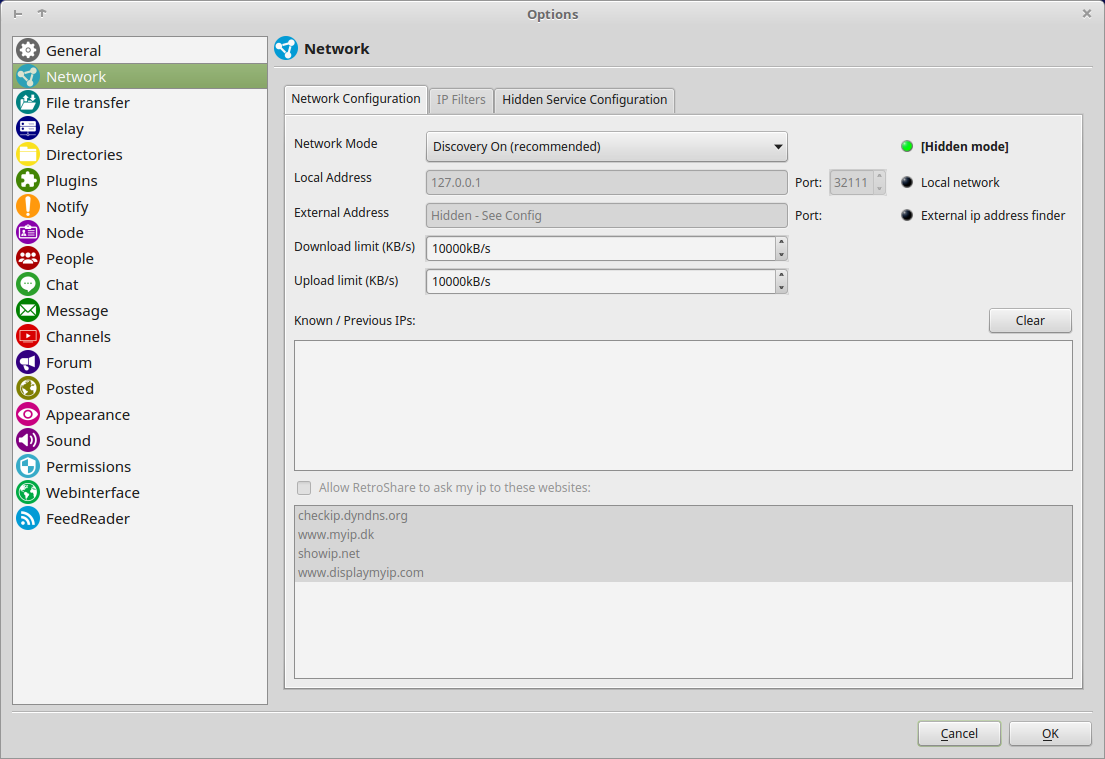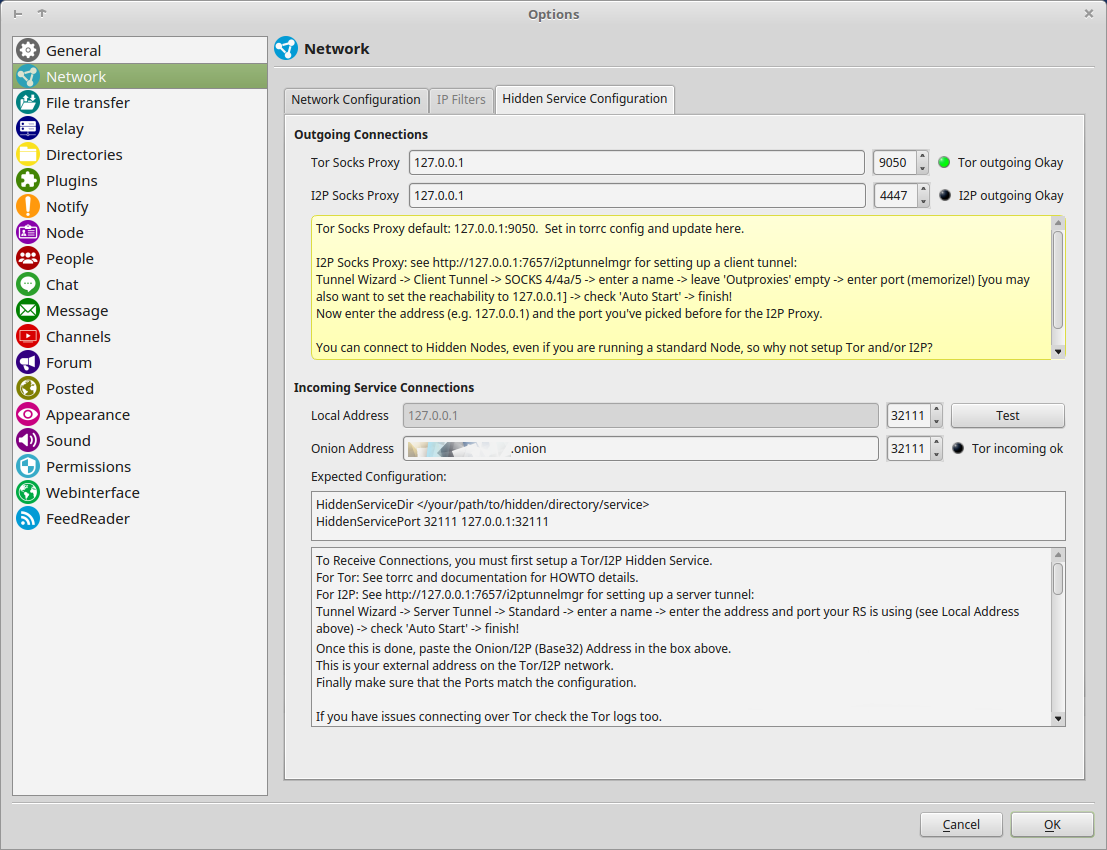Tor Hidden RetroShare Nodes
If you want to use Tor for anonymous web browsing, please use Tor
Browser.
It comes with readily configured Tor and a browser patched
for better anonymity.
To use SOCKS-Proxy directly (for RetroShare, instant
messaging, Jabber, IRC, etc), you can point your application directly at
Tor (localhost port 9050, or port 9150 for Tor Browser), but see this
FAQ entry
for why this may be dangerous.
RetroShare can be run behind a Tor Hidden Service
for incoming connections. The outgoing connections are sent through a
local Tor-Socks-Proxy.
This makes it possible to obfuscate your metadata which could
disclose your Network Friend Graph.
The hidden service address (e.g. ld546kr3zr462z3p.onion) is replacing
the IPv4 address (e.g. 192.168.1.216) as the listening address for incoming
connections.
Tor allows clients and relays to offer hidden services. That is, you can offer a web server, SSH server, etc., without revealing your IP address to its users. In fact, because you don't use any public address, you can run a hidden service from behind your firewall.
Hidden Service Setup
Tor Installation
This Guide requires to have Tor already installed on your System.
If not, please refer to the offical Tor Documentation on how to install Tor.
Outgoing Tor Proxy
By default Tor will create a SOCKS Proxy on localhost for outgoing connections.
## Tor opens a SOCKS proxy on port 9050 by default -- even if you don't
## configure one below. Set "SOCKSPort 0" if you plan to run Tor only
## as a relay, and not make any local application connections yourself.
#SOCKSPort 9050 # Default: Bind to localhost:9050 for local connections.
#SOCKSPort 192.168.0.1:9100 # Bind to this address:port too.
Configure your hidden service
On Debian/Ubuntu Systems go to your tor settings directory /etc/tor. Open your torrc file in your favorite text editor. Go to the middle section and look for the line:
############### This section is just for location-hidden services ###
## Once you have configured a hidden service, you can look at the
## contents of the file ".../hidden_service/hostname" for the address
## to tell people.
##
## HiddenServicePort x y:z says to redirect requests on port x to the
## address y:z.
#HiddenServiceDir /var/lib/tor/hidden_service/
#HiddenServicePort 80 127.0.0.1:80
#HiddenServiceDir /var/lib/tor/other_hidden_service/
#HiddenServicePort 80 127.0.0.1:80
#HiddenServicePort 22 127.0.0.1:22
The HiddenServicePort directive contains the port where the Hidden Service should listen and the local IP and the local Port where RetroShare is listening.
Add a section for your hidden service.
HiddenServiceDir /var/lib/tor/hidden_rs_revy/
HiddenServicePort 32111 127.0.0.1:32111
- HiddenServiceDir
The HiddenServiceDir directive tells Tor where to look for the Hidden Service Directory containing the private key of the Hidden Service. Each Hidden Service Owns it's own directory. The directory needs to be created and having permissions of the Tor User. - HiddenServicePort
The HiddenServicePort directive tells tor on which port to listen, to forward to which ip and to which port.
Go to /var/lib/tor/ and create a directory for your new Hidden Service. Change the owner of the directory to the user running tor.
root@laptop:/var/lib/tor# mkdir hidden_rs_revy
root@laptop:/var/lib/tor# chown debian-tor:debian-tor hidden_rs_revy/
root@laptop:/var/lib/tor# chmod 0700 hidden_rs_revy/
root@laptop:/var/lib/tor# ls -lha
total 9.8M
drwx--S--- 5 debian-tor debian-tor 4.0K Oct 23 12:26 .
drwxr-xr-x 74 root root 4.0K Apr 29 20:23 ..
drwxr-sr-x 3 debian-tor debian-tor 4.0K Oct 21 21:34 .arm
drwx--S--- 2 debian-tor debian-tor 4.0K Oct 23 12:26 hidden_rs_revy
-rw------- 1 debian-tor debian-tor 0 Oct 23 09:25 lock
-rw------- 1 debian-tor debian-tor 6.1K Oct 23 12:26 state
Restart your Tor Daemon. Tor will create a crypto key for your Hidden Service in the HiddenServiceDirectory.
root@laptop:/var/lib/tor# /etc/init.d/tor restart
[ ok ] Stopping tor daemon...done.
[ ok ] Starting tor daemon...done.
root@laptop:/var/lib/tor# cd hidden_rs_revy/
root@laptop:/var/lib/tor/hidden_rs_revy# ls
hostname private_key
The Hostname of your new Hidden Service will be available in the file hostname just created in your Hidden Service Directory.
root@laptop:/var/lib/tor/hidden_rs_revy# cat hostname
ld546kr3zr462z3p.onion
RetroShare Tor Setup
For more details please also read Create New User for clearnet IPv4 Network Node.
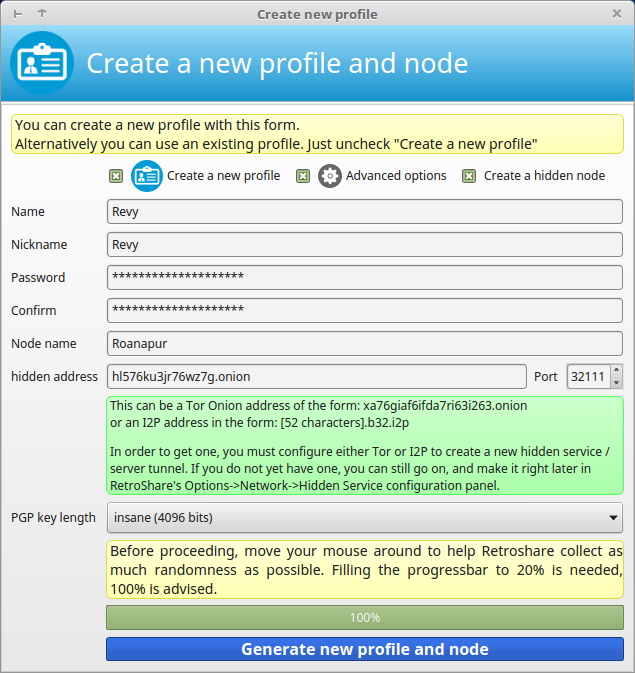
Network Configuration
Check your Network Config. It should look different to a normal setting.
- Hidden Node Indicator
- DHT is disabled in Network Mode
Discovery is recommended, though also Darknet(Discovery & DHT are disabled) may be used. - Local Address is locked to localhost (127.0.0.1)
- external Address is hidden
- Known / Previous IPs are disabled
- external IP Checks are disabled
Hidden Service Configuration
Outgoing Connections
- Tor Socks Proxy Your Tor Socks Proxy is normally available at localhost and port 9050.
- The Indicator shows if the proxy is working.
- I2P Socks Proxy
I2P also creates a SOCKS Proxy, which can be used to connect to I2P Hidden RetroShare Nodes.
Incoming Connections
- Local Address
This Address is locked to 127.0.0.1
- Local Port
The Port where RetroShare is listening
- Local Port
- Onion Address
Here you need to enter the Hostname which has been created by the Tor HiddenServiceDir.- Onion Port
The Port where the Hidden Service is listening
- Onion Port
For an easier usage, both ports should be used symmetrically.
Tor Proxy Usage
Normal Nodes
Normal Nodes may also use Tor Socks Proxy for outgoing connections to Hidden Services.
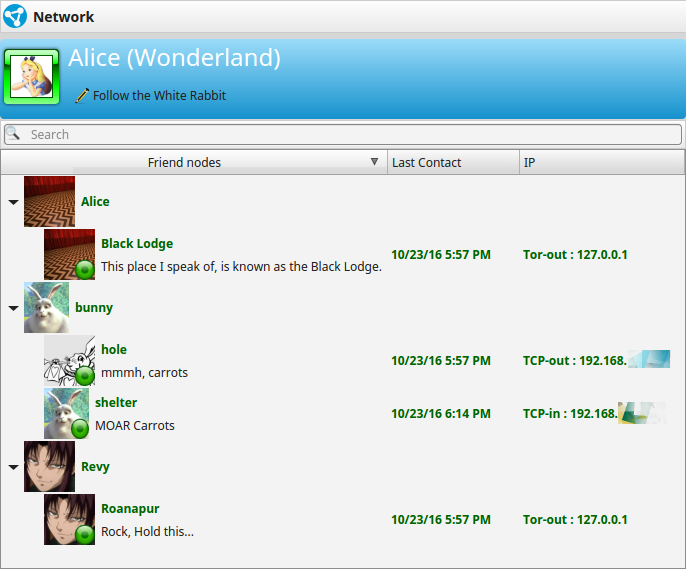
Outgoing Tor Connections and Incoming&Outgoing TCP Connections
Hidden Nodes
Outgoing connections are always routed through the local Tor Socks Proxy to .onion addresses. All Traffic is routed inside the Tor Network. Hidden Nodes cannot connect to IPv4/Normal Nodes, because Tor-Exit nodes are not used. Though the other way Normal Nodes can reach Hidden Nodes through Tor Socks Proxy.
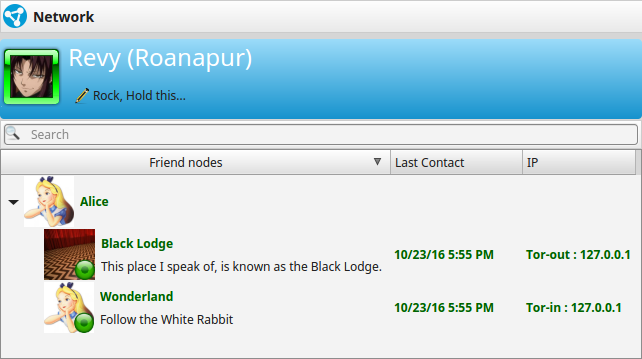
Tor connections incoming and outgoing from and to Hidden Nodes.
